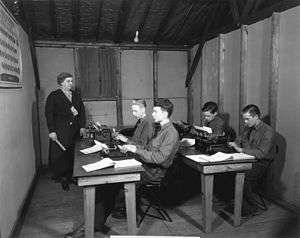Typing
Typing is the process of writing or inputting text by pressing keys on a typewriter, computer keyboard, cell phone, or calculator. It can be distinguished from other means of text input, such as handwriting and speech recognition. Text can be in the form of letters, numbers and other symbols. The world's first typist was Lillian Sholes from Wisconsin,[1][2] the daughter of Christopher Sholes, who invented the first practical typewriter.[1]

User interface features such as spell checker and autocomplete serve to facilitate and speed up typing and to prevent or correct errors the typist may make.
Technique
Touch typing
The basic technique stands in contrast to hunt and peck typing in which the typist keeps their eyes on the source copy at all times. Touch typing also involves the use of the home row method, where typists keep their wrists up, rather than resting them on a desk or keyboard (which can cause carpal tunnel syndrome). To avoid this, typists should sit up tall, leaning slightly forward from the waist, place their feet flat on the floor in front of them with one foot slightly in front of the other, and keep their elbows close to their sides with forearms slanted slightly upward to the keyboard; fingers should be curved slightly and rest on the home row.
Many touch typists also use keyboard shortcuts when typing on a computer. This allows them to edit their document without having to take their hands off the keyboard to use a mouse. An example of a keyboard shortcut is pressing the Ctrl key plus the S key to save a document as they type, or the Ctrl key plus the Z key to undo a mistake. Other shortcuts are the Ctrl key plus the C to copy and the Ctrl key and the v key to paste, and the Ctrl key and the X key to cut. Many experienced typists can feel or sense when they have made an error and can hit the ← Backspace key and make the correction with no increase in time between keystrokes.
Hunt and peck
Hunt and peck (two-fingered typing) is a common form of typing in which the typist presses each key individually. Instead of relying on the memorized position of keys, the typist must find each key by sight. Use of this method may also prevent the typist from being able to see what has been typed without glancing away from the keys. Although good accuracy may be achieved, any typing errors that are made may not be noticed immediately due to the user not looking at the screen. There is also the disadvantage that because fewer fingers are used, those that are used are forced to move a much greater distance.

Hybrid
There are many idiosyncratic typing styles in between novice-style "hunt and peck" and touch typing. For example, many "hunt and peck" typists have the keyboard layout memorized and are able to type while focusing their gaze on the screen. Some use just two fingers, while others use 3–6 fingers. Some use their fingers very consistently, with the same finger being used to type the same character every time, while others vary the way they use their fingers.
One study examining 30 subjects, of varying different styles and expertise, has found minimal difference in typing speed between touch typists and self-taught hybrid typists.[3] According to the study, "The number of fingers does not determine typing speed... People using self-taught typing strategies were found to be as fast as trained typists... instead of the number of fingers, there are other factors that predict typing speed... fast typists... keep their hands fixed on one position, instead of moving them over the keyboard, and more consistently use the same finger to type a certain letter." To quote doctoral candidate Anna Feit: "We were surprised to observe that people who took a typing course, performed at similar average speed and accuracy, as those that taught typing to themselves and only used 6 fingers on average"
Buffering
Some people combine touch typing and hunt and peck by using a buffering method. In the buffer method, the typist looks at the source copy, mentally stores one or several sentences, then looks at the keyboard and types out the buffer of sentences. This eliminates frequent up and down motions with the head and is used in typing competitions in which the typist is not well versed in touch typing. Not normally used in day-to-day contact with keyboards, this buffer method is used only when time is of the essence.
Thumbing
A late 20th century trend in typing, primarily used with devices with small keyboards (such as PDAs and Smartphones), is thumbing or thumb typing. This can be accomplished using one or both thumbs. Similar to desktop keyboards and input devices, if a user overuses keys which need hard presses and/or have small and unergonomic layouts, it could cause thumb tendonitis or other repetitive strain injury.
Words per minute
Words per minute (WPM) is a measure of typing speed, commonly used in recruitment. For the purposes of WPM measurement a word is standardized to five characters or keystrokes. Therefore, "brown" counts as one word, but "mozzarella" counts as two.
The benefits of a standardized measurement of input speed are that it enables comparison across language and hardware boundaries. The speed of an Afrikaans-speaking operator in Cape Town can be compared with a French-speaking operator in Paris.
Alphanumeric entry
In one study of average computer users, the average rate for transcription was 33 words per minute, and 19 words per minute for composition.[4] In the same study, when the group was divided into "fast", "moderate" and "slow" groups, the average speeds were 40 wpm, 35 wpm, and 23 wpm respectively. An average professional typist reaches 50 to 80 wpm, while some positions can require 80 to 95 wpm (usually the minimum required for dispatch positions and other typing jobs), and some advanced typists work at speeds above 120 wpm.[5][6] Two-finger typists, sometimes also referred to as "hunt and peck" typists, commonly reach sustained speeds of about 37 wpm for memorized text and 27 wpm when copying text, but in bursts may be able to reach speeds of 60 to 70 wpm.[7] From the 1920s through the 1970s, typing speed (along with shorthand speed) was an important secretarial qualification and typing contests were popular and often publicized by typewriter companies as promotional tools.
A less common measure of the speed of a typist, CPM is used to identify the number of characters typed per minute. This is a common measurement for typing programs, or typing tutors, as it can give a more accurate measure of a person's typing speed without having to type for a prolonged period of time. The common conversion factor between WPM and CPM is 5. It is also used occasionally for associating the speed of a reader with the amount they have read. CPM has also been applied to 20th century printers, but modern faster printers more commonly use PPM (pages per minute).
The fastest typing speed ever, 240 words per minute, was achieved by Chakk in 2020 in one minute on an unknown keyboard[8][9][10][11] using the QWERTY key layout.[12][13] As of 2005, Joshua Hu was the fastest English language typist in the world, according to YouTube. Using the QWERTY keyboard layout, he had maintained 180 wpm for 50 minutes, and 220 wpm for shorter periods, with a peak speed of 224 wpm.[14][15]
The recent emergence of several competitive typing websites has allowed several fast typists on computer keyboards to emerge along with new records, though these are unverifiable for the most part. Two of the most notable online records that are considered genuine are 251.21 wpm on an English text on typingzone.com by Brazilian Guilherme Sandrini (equivalent to 301.45 wpm using the traditional definition for words per minute since this site defines a word as six characters rather than five)[16] and 256 wpm (a record caught on video) on TypeRacer by American Sean Wrona, the inaugural Ultimate Typing Championship winner, which was considered the highest ever legitimate score ever set on the site, until Wrona claimed it has been surpassed.[17] Both of these records are essentially sprint speeds on short text selections lasting much less than one minute and were achieved on the QWERTY keyboard. Wrona also maintained 174 wpm on a 50-minute test taken on hi-games.net, another online typing website to unofficially displace Blackburn as the fastest endurance typist, although disputes might still arise over differences in the difficulty of the texts as well as Wrona's use of a modern computer keyboard as opposed to the typewriter used by Blackburn. [18][19] Later, Michael DeRoche had broke Guilherme Sandrini's record at 265.78 wpm on July 2019 TypingZone master (about 318 wpm). Using a personalized interface, physicist Stephen Hawking, who suffered from amyotrophic lateral sclerosis, managed to type 15 wpm with a switch and adapted software created by Walt Woltosz. Due to a slowdown of his motor skills, his interface was upgraded with an infrared camera that detected "twitches in the cheek muscle under the eye."[20] His typing speed decreased to approximately one word per minute in the later part of his life.[21]
Numeric entry
The numeric entry, or 10-key, speed is a measure of one's ability to manipulate a numeric keypad.
Text-entry research
Error analysis
With the introduction of computers and word-processors, there has been a change in how text-entry is performed. In the past, using a typewriter, speed was measured with a stopwatch and errors were tallied by hand. With the current technology, document preparation is more about using word-processors as a composition aid, changing the meaning of error rate and how it is measured. Research performed by R. William Soukoreff and I. Scott MacKenzie, has led to a discovery of the application of a well-known algorithm. Through the use of this algorithm and accompanying analysis technique, two statistics were used, minimum string distance error rate (MSD error rate) and keystrokes per character (KSPC). The two advantages of this technique include:
- Participants are allowed to enter text naturally, since they may commit errors and correct them.
- The identification of errors and generation of error rate statistics is easy to automate.
Deconstructing the text input process
Through analysis of keystrokes, the keystrokes of the input stream were divided into four classes: Correct (C), Incorrect Fixed (IF), Fixes (F), and Incorrect Not Fixed (INF). These key stroke classification are broken down into the following
- The two classes Correct and Incorrect Not Fixed comprise all of the characters in transcribed text.
- Fixes (F) keystrokes are easy to identify, and include keystrokes such as backspace, delete, cursor movements, and modifier keys.
- Incorrect Fixed (IF) keystrokes are found in the input stream, but not the transcribed text, and are not editing keys.
Using these classes, the Minimum String Distance Error Rate and the Key Strokes per Character statistics can both be calculated.
Minimum string distance error rate
The minimum string distance (MSD) is the number of "primitives" which is the number of insertions, deletions, or substitutions to transform one string into another. The following equation was found for the MSD Error Rate
MSD Error Rate =
Key strokes per character (KSPC)
With the minimum string distance error, errors that are corrected do not appear in the transcribed text. The following example will show you why this is an important class of errors to consider:
Presented Text: the quick brown
Input Stream: the quix<-ck brown
Transcribed Text: the quick brown
in the above example, the incorrect character ('x') was deleted with a backspace ('<-'). Since these errors do not appear in the transcribed text, the MSD error rate is 0%. This is why there is the key strokes per character (KSPC) statistic.
KSPC =
The three shortcomings of the KSPC statistic are listed below:
- High KSPC values can be related to either many errors which were corrected, or few errors which were not corrected; however, there is no way to distinguish the two.
- KSPC depend on the text input method, and cannot be used to meaningfully compare two different input methods, such as Qwerty-keyboard and a multi-tap input.
- There is no obvious way to combine KSPC and MSD into an overall error rate, even though they have an inverse relationship.
Further metrics
Using the classes described above, further metrics were defined by R. William Soukoreff and I.Scott MacKenzie:
Error correction efficiency refers to the ease with which the participant performed error correction.
- Correction Efficiency = IF/F
Participant conscientiousness is the ratio of corrected errors to the total number of error, which helps distinguish perfectionists from apathetic participants.
- Participant Conscientiousness = IF / (IF + INF)
If C represents the amount of useful information transferred, INF, IF, and F represent the proportion of bandwidth wasted.
- Utilized Bandwidth = C / (C + INF + IF + F)
- Wasted Bandwidth = (INF + IF + F)/ (C + INF + IF + F)
Total error rate
The classes described also provide an intuitive definition of total error rate:
- Total Error Rate = ((INF + IF)/ (C + INF + IF)) * 100%
- Not Corrected Error Rate = (INF/ (C + INF + IF)) * 100%
- Corrected Error Rate = (IF/ (C + INF + IF)) * 100%
Since these three error rates are ratios, they are comparable between different devices, something that cannot be done with the KSPC statistic, which is device dependent.[22]
Tools for text entry research
Currently, two tools are publicly available for text entry researchers to record text entry performance metrics. The first is TEMA[23] that runs only on the Android (operating system). The second is WebTEM that runs on any device with a modern Web browser, and works with almost all text entry technique.[24]
Keystroke dynamics
Keystroke dynamics, or typing dynamics, is the obtaining of detailed timing information that describes exactly when each key was pressed and when it was released as a person is typing at a computer keyboard for the identification of humans by their characteristics or traits,[25] similar to speaker recognition.[26] Data needed to analyze keystroke dynamics is obtained by keystroke logging.
The behavioral biometric of Keystroke Dynamics uses the manner and rhythm in which an individual types characters on a keyboard or keypad.[27]
Typing Test
Standard typing test or the typing speed test is the checking of number of words you can type in a minute. It is a efficiency test test where your typing skills can be expressed in words per minute. Every typing test has a different difficulty level which is dependent on the length and pattern of keystrokes of a word.
See also

References
- "World's First Typist". Wisconsin Historical Society. Retrieved 2010-09-11.
- "Wisconsin History Facts". e-ReferenceDesk. Retrieved 2010-09-11.
- "Ten fingers not needed for fast typing, study shows". phys.org.
- Karat, C.M., Halverson, C., Horn, D. and Karat, J. (1999), Patterns of entry and correction in large vocabulary continuous speech recognition systems, CHI 99 Conference Proceedings, 568-575.
- Ayres, Robert U; Martinás, Katalin (2005), "120 wpm for very skilled typist", On the Reappraisal of Microeconomics: Economic Growth and Change in a Material World, Cheltenham, UK & Northampton, Massachusetts: Edward Elgar Publishing, p. 41, ISBN 1-84542-272-4, retrieved 22 November 2010
- Teresia R. Ostrach (1997), Typing Speed: How Fast is Average (PDF), archived from the original (PDF) on 2012-05-02
- Brown, C. M. (1988). Human-computer interface design guidelines. Norwood, NJ: Ablex Publishing.
- "History of Typewriters | Big Site of Amazing Facts ®". Bigsiteofamazingfacts.com. Retrieved 2012-06-13.
- "World Records in Typing". Owled.com. 2006-09-02. Retrieved 2012-06-13.
- "IBM Archives: Typing posture". 03.ibm.com. Retrieved 2012-06-13.
- "Believe it or not ..." Deskstore.com. Retrieved 2012-06-13.
- url=http://thekindle3books.com/qwerty-vs-dvorak-the-two-great-keyboards-the-time-were-born/
- url=https://www.pond5.com/stock-footage/75268195/miss-stella-pajunas-worlds-fast-typist-types-ibm-electric-ty.html
- "Barbara Blackburn, the World's Fastest Typist". Retrieved 2008-05-08.
- Don Giller (2016-05-06), The Great Typing Controversy on Late Night, January 24 and 28, 1985, retrieved 2017-07-05
- Jean-Didier Febvay & Jonathan Gutierrez. "international typing speed contest". Typing Zone. Retrieved 2019-01-17.
- "256 wpm race - former all-time TypeRacer record". YouTube. Retrieved December 3, 2016.
- "Typing - Replay of Sean Wrona's highscore of 174 wpm". hi-games.net. Retrieved 2012-06-13.
- "Sean Wrona, official site".
- "How Does Stephen Hawking Talk? (video)". Singularity Hub. 2010-05-03. Retrieved 2012-06-13.
- "The man who saves Stephen Hawking's voice". newscientist.com.
- "Soukoreff, R. W., & MacKenzie, I. S. (2003). Metrics for text entry research: An evaluation of MSD and KSPC, and a new unified error metric. Proceedings of the ACM Conference on Human Factors in Computing Systems - CHI 2003, pp. 113-120. New York: ACM".
- Castellucci, Steven J.; MacKenzie, I. Scott (2011-01-01). "Gathering Text Entry Metrics on Android Devices". CHI '11 Extended Abstracts on Human Factors in Computing Systems. CHI EA '11. New York, NY, USA: ACM: 1507–1512. doi:10.1145/1979742.1979799. ISBN 9781450302685.
- Arif, Ahmed Sabbir; Mazalek, Ali (2016-01-01). "WebTEM: A Web Application to Record Text Entry Metrics". Proceedings of the 2016 ACM on Interactive Surfaces and Spaces. ISS '16. New York, NY, USA: ACM: 415–420. doi:10.1145/2992154.2996791. ISBN 9781450342483.
- "User authentication through typing biometrics features" (PDF). pku.edu.cn.
- Robert Moskovitch , Clint Feher , Arik Messerman , Niklas Kirschnick , Tarik Mustafic , Ahmet Camtepe , Bernhard Löhlein , Ulrich Heister , Sebastian Möller , Lior Rokach , Yuval Elovici (2009). Identity theft, computers and behavioral biometrics (PDF). Proceedings of the IEEE International Conference on Intelligence and Security Informatics. pp. 155–160.CS1 maint: multiple names: authors list (link)
- "Continuous authentication by analysis of keyboard typing characteristics - IET Conference Publication". ieeexplore.ieee.org. doi:10.1049/cp:19950480.
| Wikiversity has learning resources about Typing |
